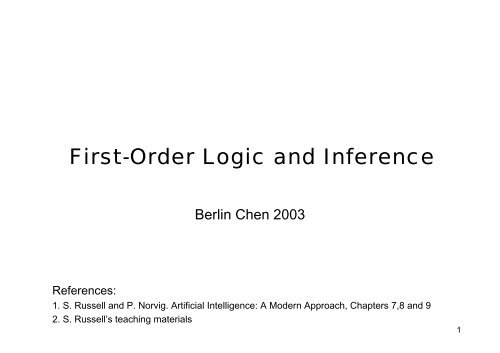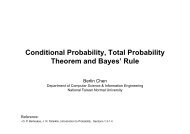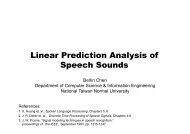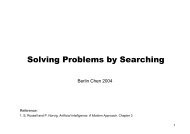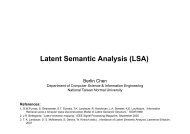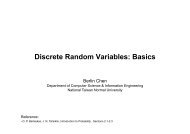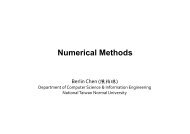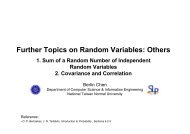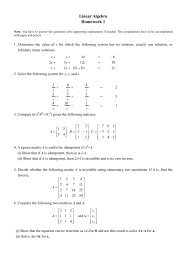First-Order Logic and Inference - Berlin Chen
First-Order Logic and Inference - Berlin Chen
First-Order Logic and Inference - Berlin Chen
You also want an ePaper? Increase the reach of your titles
YUMPU automatically turns print PDFs into web optimized ePapers that Google loves.
<strong>First</strong>-<strong>Order</strong> <strong>Logic</strong> <strong>and</strong> <strong>Inference</strong><strong>Berlin</strong> <strong>Chen</strong> 2003References:1. S. Russell <strong>and</strong> P. Norvig. Artificial Intelligence: A Modern Approach, Chapters 7,8 <strong>and</strong> 92. S. Russell’s teaching materials1
Pros <strong>and</strong> Cons of Propositional <strong>Logic</strong> (PL)• PL is declarative– Pieces of syntax correspond to facts– Knowledge <strong>and</strong> inference are separate <strong>and</strong> inference is entirelydomain-independent• PL is compositional– Meaning of a sentence is a function of the meaning of its parts– E.g., meaning of B 1,1 ∧ P 1,2 is derived from meaningof B 1,1 <strong>and</strong> of P 1,2• PL can deal with partial information• The meaning of PL is context-independent• PL has very limited expressive power– E.g., cannot say “pits cause breezes in adjacent squares” exceptby writing one sentence for each squareB 1,1⇔ (P 1,2∨ P 2,1),B 2,1⇔ (P 1,1∨ P 2,2∨ P 3,1), ….The lack of concise representations2
Natural Languages• Natural Languages are– Very expressive– Mediums for communication rather than pure representation– Content-dependent– Not purely compositional– Ambiguous• Major elements of natural Languages– Nouns <strong>and</strong> noun phrases: refer to objects• E.g., people, houses, colors, …– Verbs <strong>and</strong> verb phrases: refer to relations among objects• E.g., is red, is round, (properties)…; is brother of, has color, …– Some of the relations are functions which return one value for agiven input• E.g., father of, best friend, beginning of, …3
<strong>First</strong>-<strong>Order</strong> <strong>Logic</strong> (FOL)• Whereas PL assumes world containing facts, FOLassumes the world contains objects <strong>and</strong> relations– FOL can express facts about some or all the objects in theuniverse– Such as “Squares neighboring the wumpus are smelly”• Objects: things with individual identities• Relations– RelationsInterrelations among objects– Functions– Properties: distinguish objects from others4
<strong>Logic</strong>s in General5
Examples• One plus two equals three– Objects: one, two, three, one plus two– Relation: equals– Function: plus• Squares neighboring the wumpus are smelly– Objects: wumpus, square– Property: smelly– Relation: neighboring• Evil King John ruled Engl<strong>and</strong> in 1200– Objects: John, Engl<strong>and</strong>, 1200– Properties: evil, king– Relation: ruled6
Models for FOL• A model contains objects <strong>and</strong> relations among them• The domain of a model is the set of objects– Objects are domain elements• Example5 objects: Richard, John, Richard’s left legs, John’s left legs, crown2 binary relations: brother, on head3 unary relations: person, king, crown1 unary function: left leg7
Syntax of FOL• BNF (Backus-Naur Form) grammar for FOLSentence → AtomicSentence| (Sentence Connective Sentence)| Quantifier Variables, Sentence| ¬SentenceAtomicSentence → Predicate(Term, …) | Term = TermTerm → Function(Term, …)| Constant| Variablerelations, propertiescomplex termsConnective → ⇒ | ∧ | ∨ | ⇔Quantifier → ∀ | ∃Constant → A | X 1| John | …Variable → a | x | s | …Predicate → Before | HasColor | Raining | …Function → Mother | LeftLeg | …8
Semantics of FOL• The truth of any sentences is determined by a model <strong>and</strong>an interpretation for the sentence’s symbols• Interpretation specifies exactly which objects, relations<strong>and</strong> functions are referred by the constant, predicate,<strong>and</strong> function symbols– Constant symbols → objects– Predicate symbols → relations, properties– Function symbols → functional relations• An atomic sentence Predicate(Term 1 , …,Term n ) is true iffthe objects referred to by Term 1 , …,Term n are in therelation referred to by Predicate9
Terms• A term is a logic expression that refers to an object• Simple term: e.g., constant/variable symbols• Complex term: formed by a function symbol followed aparenthesized list of terms as arguments to the functionsymbol– The complex term refers to an object that is the value of thefunction (symbol) applied to the arguments– E.g., LeftLeg(John)function symbolargument/term10
Atomic Sentences• An atomic sentence is formed by– A predicate symbol followed by a parenthesized list of terms• Predicate(Term 1,…, term n)• E.g., Brother( Richard, John)– Or just term 1 =term 2• Atomic sentences can have complex terms as argument– E.g., Married( Father( Richard), Mother( John))11
Complex Sentences• An complex sentence is constructed using logicalconnectives– Negation¬Brother(LeftLeg(Richard), John)– ConjunctionBrother(Richard, John)∧Brother(John, Richard)– DisjunctionKing(Richard)∨King(John)– Implication¬King(Richard) ⇒ King(John)The truth or falsity of a complex sentence can be determined fromthe truth or falsity of its component sentences12
Universal Quantification• The following sentence remains truth for all valuesof the variable∀〈variable〉〈sentence〉– Variables are lowercase– E.g., “Everyone in Taiwan is industrious”∀x In(x, Taiwan) ⇒ Industrious(x)∀x P is true in a model m iff P with x being eachpossible object in the model- Equivalent to the conjunction of instantiations of PIn(Thmoas, Taiwan) ⇒ Industrious(Thmoas)∧In(Rich, Taiwan) ⇒ Industrious(Rich)∧In(Vicent, Taiwan) ⇒ Industrious(Vicent)∧In(Eileen, Taiwan) ⇒ Industrious(Eileen)∧ ……13
Universal Quantification: A Common Mistake• Typically, ⇒ (implication) is the main connective with ∀• Common mistake: using ∧ as the main connective with ∀∀x In(x, Taiwan) ∧ Industrious(x)Means “ Everyone is in Taiwan <strong>and</strong> everyone is industrious”14
Existential Quantification• The following sentence remains true for all valuesof the variable∃〈variable〉〈sentence〉– E.g., “Someone in Taiwan is industrious”∃x In(x, Taiwan) ∧ Industrious(x)∃x P is true in a model m iff P with x being eachpossible object in the model- Equivalent to the disjunction of instantiations of P(In(Thmoas, Taiwan) ∧Industrious(Thmoas))∨ (In(Rich, Taiwan) ∧ Industrious(Rich))∨ (In(Vicent, Taiwan) ∧ Industrious(Vicent))∨ (In(Eileen, Taiwan) ∧ Industrious(Eileen))∨ ……15
Existential Quantification : A Common Mistake• Typically, ∧ is the main connective with ∃• Common mistake: using ⇒ as the main connective with ∃∃ x In(x, Taiwan) ⇒ Industrious(x)Is true if there is anyone who is not in Taiwan16
• Nested QuantifiersProperties of Quantifiers∀x ∀y is the same as ∀y ∀x∃x ∃y is the same as ∃y ∃x∃x ∀y is the same as ∀y ∃x– Examples:• “There is a person who loves everyone in the world”∃x ∀y Loves(x, y)• “Everyone in the world is loved by at least one person”∀y ∃x Loves(x, y)• Quantifier Duality– Each of the following sentences can be expressed using theother∀x Likes(x, IceCream) ¬∃x ¬Likes(x, IceCream)∃x Likes(x, IceCream) ¬∀x ¬Likes(x, IceCream)17
Equality• Make statements to the effect that two terms refer to thesame object– Determine the truth of an equality sentence by seeing that thereferents of the two terms are the same objects– E.g.,: state the facts about a given functionFather(John)=Henry– E.g., insist that two terms are not the same objects∃x∃y Brother(x,Richard)∧Brother(y,Richard)∧¬(x=y)• Richard has at least two brothers18
Review: De Morgan’s Rules∀x ¬P ≣ ¬∃x P ¬P∧¬Q ≣¬(P ∨Q )¬∀x P ≣ ∃x ¬ P ¬(P∧Q) ≣¬P ∨¬Q∀x P ≣ ¬∃x ¬ P P∧Q ≣¬(¬P ∨¬Q )∃x P ≣ ¬∀x ¬ P P∨Q ≣¬(¬P ∧¬Q )19
Using <strong>First</strong>-<strong>Order</strong> <strong>Logic</strong>• Assertions <strong>and</strong> Queries– Assertions:• Sentences are added to KB using TELL, such sentencesare called assertionsTELL(KB, King(John))TELL(KB, ∀x King(x) ⇒ Person(x) )– Queries• Questions are asked using ASK, which are also called queriesor goalsASK(KB, King(John))return trueASK(KB, Person(John)return trueASK(KB, ∃x Person (x))return {x/John}A substitutionor binding list20
Using <strong>First</strong>-<strong>Order</strong> <strong>Logic</strong>• Example: The Kinship Domain– One’s mother is one’s female parent∀m,c Mother(m, c) ⇔ (Female(m) ∧ Parent(m, c))– One’s husb<strong>and</strong> is one’s male spouse∀w,h Husb<strong>and</strong>(h, w) ⇔ (Male(h) ∧ Spouse(h, w))– A gr<strong>and</strong>parent is a a parent of one’s parent∀g,c Gr<strong>and</strong>parent(g, c) ⇔ (∃p Parent(g, p)∧Parent(p, c))– A sibling is another child of one’s parents∀x,y Sibling (x, y) ⇔ x≠y ∧ ( ∃p Parent(p, x)∧Parent(p, y))– A first cousin is a child of a parent’s sibling∀x,y <strong>First</strong>Cousin(x, y) ⇔ ∃p,ps Parent(p, x) ∧ Sibling(ps, p)∧ Parent(ps, y)21
Interacting with FOL KBs• Suppose a wumpus-world agent is using an FOL KB<strong>and</strong> perceives a stench <strong>and</strong> a breeze (but no glitter)at t = 5stench breeze glitter bump screamTell(KB, percept([Stench, Breeze, None, None, None], 5))Ask(KB, ∃a BestAction(a, 5))– Does the KB entail any particular actions at t = 5?Answer: Yes, {a/shoot}A substitution or binding list• Given a sentence S <strong>and</strong> a substitution θ, SUBST(θ, S)denotes the result of plugging θ into S ; e.g.,S=Smarter(x, y)θ={x/Vicent, y/Thmoas}SUBST(θ, S) =Smarter(Vicent, Thmoas)– ASK(KB, S) returns some/all θ (substitution, binding list) suchthat KB |= SUBST(θ, S)22
KB for the Wumpus World• Perception• Reflex∀t, s, g ,m, c Percept([s, Breeze, g, m, c], t) ⇒ Breeze(t)∀t, s, b ,m, c Percept([s, b, Glitter, m, c], t) ⇒ Glitter(t)∀t Glitter (t) ⇒ BestAction(Grab, t)• Environmentstench breeze glitter bump scream∀x , y, a, b Adjacent([x,y], [a,b]) ⇔[a,b] ∈{[x+1, y], [x-1, y], [x, y+1] [x, y-1]}• Properties of agent’s locations∀s, t At(Agent, s, t) ∧ Breeze(t) ⇒ Breezy(s)23
KB for the Wumpus World• Square are breezy near a pit– Diagnostic rule – infer hidden causes from observable effects• If a square is breezy , some adjacent square must contain a pit∀s Breezy(s) ⇒∃r Adjacent(r, s)∧Pit(r)• If a square is not breezy , no adjacent square contains a pit∀s ¬Breezy(s) ⇒¬∃r Adjacent(r, s) ∧Pit(r)• Combined:∀s Breezy(s) ⇔∃ r Adjacent(r, s)∧Pit(r)model-basedreasoning– Causal rule – infer observable effects from hidden causes• A pit causes all adjacent squares to be breezy∀r Pit(r) ⇒[∀s Adjacent(r, s) ⇒ Breezy(s) ]• If all squares adjacent to a given square are pitless, the square willnot be breezy∀s [∀r Adjacent(r, s) ⇒¬Pit(r)] ⇒¬Breezy(s)• Combined:∀s Breezy(s) ⇔∃ r Adjacent(r, s)∧Pit(r)24
<strong>Inference</strong> Rules for Quantifiers• Substitution SUBST(θ,α)– Refer to applying the substitution θ to the sentence α– θ is a set of variable/(ground)term pairsθ={x/John}Person(x) Person(John)• Universal Instantiation (UI)SUBST(θ,α)– Infer any sentence obtained by substituting a ground term for theuniversally quantified variable– A ground term is a term without variable• could be a complex term∀v αSUBST({v/g}, α)θ={x/John}∀x King(x)∧Greedy(x) ⇒ Evil(x)King(John)∧Greedy(John) ⇒ Evil(John)25
<strong>Inference</strong> Rules for Quantifiers• Existential Instantiation (EI)– Infer any sentence obtained by substituting a new constantsymbol that does not appear elsewhere in the KB for theexistentially quantified variable∃ v αSUBST({v/k}, α)θ={x/C 1 }∃x Crown(x)∧OnHead(x, John)Crown(C 1 )∧OnHead(C1, John)– A new constant symbol called Skolem constant26
Universal/Existential Instantiation• Universal instantiation can be applied several times toadd new sentences– The new KB is logically equivalent to the old one• Existential instantiation can be applied just once toreplace the existential sentence– The new KB is not equivalent to the old one– But is satisfiable iff the old KB was satisfiable27
Reduction to Propositional <strong>Inference</strong>• Suppose the KB contains:∀x King(x) ∧ Greedy(x) ⇒ Evil(x)King(John)Greedy(John)Brother(Richard, John)• Instantiate the universal sentence in all possible ways:King(John) ∧ Greedy(John) ⇒ Evil(John)King(Richard) ∧ Greedy(Richard) ⇒ Evil(Richard)King(John)Greedy(John)Brother(Richard, John)• The new KB is propositionalized– View the ground atomic sentences as propositional symbolsKing(John), Greedy(John), Evil(John), King(Richard), etc.28
Reduction to Propositional <strong>Inference</strong>• Claims– A ground sentence is entailed by new KB iff entailed by originalKB– Every FOL KB can be propositionalized so as to preserveentailment• Idea– Propositionalize KB <strong>and</strong> query, apply resolution, return result• Problem– When the KB includes a function symbol, there are infinitelymany ground terms can be generated from substitutions– E.g., Father(Father(Father(John)))29
Reduction to Propositional <strong>Inference</strong>• Theorem: Herbr<strong>and</strong> (1930)– If a sentence is entailed by the original FOL KB, there is a proofinvolving just a finite subset of the propositionalized KB• Idea:for n = 0 to ∞ docreate a proposional KB by instantiating with depth-n termssee if the sentence α is entailed by this KB• Problem– Works if α is entailed, loops if α is not entailedFather(John) Father(Father(John ))Father(Father(Father(John))) …….depth 1 depth 2 depth 3 depth n30
Reduction to Propositional <strong>Inference</strong>• Theorem: Turing (1936), Church (1936)– Entailment in FOL is semidecidable• Algorithms exists that say yes to every entailed sentence– The programs will halt• But no algorithm exists that also say no to every nonentailedsentence– The programs will stuck in a infinite loop– More deeply nested terms were generated31
Problems with Propositionalization• Propositionalization approach is rather inefficient– It seems to generate lots of irrelevant sentences– E.g., from∀x King(x) ∧ Greedy(x) ⇒ Evil(x)King(John)∀y Greedy(y)Brother(Richard, John)it seems obvious that Evil(John) , but propositionalizationproduces lots of facts such as Greedy(Richard) that are irrelevant• With pk-ary predicates <strong>and</strong> n constants,there are p∙n k instantiations32
Generalized Modus Ponens (GMP)• For atomic sentences p i , p i ’ , <strong>and</strong> q , where there is asubstitution θ such that SUBST( θ, p i ’ ) = SUBST( θ, p i )for all iatomic sentencespp'1'2ispKingis Greedy' '1, p22', K,pn,SUBST( John) p1is King ( x)( y) p is Greedy( x)( p1∧ p ∧K∧pn⇒ q)( θ,q)2n atomic sentences p i ’1 implicationthe premises of an implicationq isEvil( x)θ is{ x / John,y / John}SUBST( θ,q) is Evil( John): a set of variable/(ground)term pairs– GMP used with KB of definite clauses (exactly one positive literal)– All variables assumed universally quantified33
Unification• A process to find a substitution θ which can be appliedto two sentences p <strong>and</strong> q to make them look the sameUNIFY(p, q) = θ where SUBST( θ, p) = SUBST( θ, q)– The UNIFY algorithm returns a unifier (θ) for the two sentences• Example– Query: KB:Knows(John, x)p qKnows(John, Jane)Knows(y, Bill)Knows(y, Mother(y))Knows(x, Elizabeth)θUNIFY(Knows(John, x), Knows(John, Jane)) ={x/Jane}UNIFY(Knows(John, x), Knows(y, Bill)) ={x/Bill, y/John}UNIFY(Knows(John, x), Knows(y, Mother(y)))={y/John, x/Mother(John)}UNIFY(Knows(John, x), Knows(x, Elizabeth)) = fail34
St<strong>and</strong>ardizing Apart• Eliminate overlap of variables to avoid clashes byRenaming variablesUNIFY(Knows(John, x), Knows(x, Elizabeth)) = failUNIFY(Knows(John, x), Knows(z 17 , Elizabeth)) ={x/Elizabeth, z 17 /John}35
Most General Unifier (MGU)• Consider the following two unificationsUNIFY(Knows(John, x), Knows(y, z)) ={y/John, x /z}Knows(John, z)UNIFY(Knows(John, x), Knows(y, z)) ={y/John, x /John , z /John}– We say the first unifier is more general than the second• It places fewer restrictions on the values of variablesKnows(John, John)• For every unifiable pairs of expressions, there is a singlemost generalized unifier (MGU)– E.g., the former unifier, {y/John, x /z}, shown above36
Unification AlgorithmAs matching a variable against acomplex term, check whetherthe variable itself occurs inside theterm.If it does, the match fails.37
Efficient Indexing <strong>and</strong> Retrieval• Predicate IndexingQuery: Knows(John, x)Employs(x, Richard)KB: Knows(x, y)Brother(John, Richard)Employs(x, y)…..– Using a hash table– Maintain indices on keys composed of a predicate plus (one toseveral) arguments38
• OperationsForward Chaining– Start with the atomic sentences (known facts) in the KB <strong>and</strong>apply Generalized Modus Ponens in the forward direction(trigger rules whose premises are satisfied)– Adding new atomic sentences (conclusions of implications)• Not just a renaming of a known fact– Repeat until the query is answered or no further inferences canbe made• To apply FC, the KB should be converted into a set ofdefinite clauses39
Definite Clauses• Are disjunctions of literals, <strong>and</strong> of which exactly one ispositive• More specifically, a definite clause either– Is an atomic clause– Or is an implication whose antecedent (premise/body) is aconjunction of positive literals <strong>and</strong> whose conclusion (head) is asingle positive literalKing(John)Greedy(y)King(x) ∧Greedy(x) ⇒ Evil(x)– Variables are assumed to be universally quantified• Not all KB can be converted into a set of definite clauses– Because of the single-positive-literal restriction40
Example KB• The law is that it is a crime for an American to sellweapon to hostile nations. The country Nono, an enemyof America, has some missiles, <strong>and</strong> all of its missileswere sold by Colonel West, who is American.• Prove that West is a criminalCriminal(West) true or false ?41
Example KB• It is a crime for an American to sell weapon to hostilenationsAmerican(x)∧Weapon(y)∧Sells(x , y, z)∧Hostile(z)⇒Criminal(x)• The country Nono has some missiles∃ xOwns(Nono, x) ∧Missile(x)Owns(Nono, M 1) 2 , Missile(M 1) 3• All its (Nono’s) missiles are sold to it by West∀ x Missile(x)∧Owns(Nono, x) ⇒Sells(West,x,Nono)• Missiles are weaponsMissile(x) ⇒ Weapon(x)• An enemy of America counts as “hostile”Enemy(x, America) ⇒ Hostile(x)56existential elimination/instantiationAND elimination41A datalog KB:composed of a set ofFOL definite clauseswith no function symbolsbackground knowledge!42
Example KB• West, who is AmericanAmerican(West)7• The country Nono, an enemy of AmericaEnemy(Nono, America)843
Example KB: FC Proof• Start with the atomic sentences (known facts) in the KBProof Tree44
Example KB: FC Proof• Apply Generalized Modus Ponens in the forwarddirection to trigger rules whose premises are satisfied• Adding new atomic sentences (conclusions)Proof Tree10911x/M15x/M146x/Nono73 2845
Example KB: FC Proof• Apply Generalized Modus Ponens in the forwarddirection to trigger rules whose premises are satisfied• Adding new atomic sentences (conclusions)Proof Tree121A fixed point is reached:no more new inferencescan be further concluded1091154673 2846
Forward Chaining Algorithmrenaming the variablespattern matchingthe new fact unified with the query47
Forward Chaining Algorithm• Problems– The inner loop (pattern matching) is very expensive– Rules will be rechecked on every iteration to see if its premisesare satisfied– Many facts generated are irrelevant to the goal48
Incremental Forward Chaining• Every new fact inferred on iteration t must be derivedfrom at least one new fact from iteration t-1– Check a rule only if its premise include a conjunct p i can beunified with a fact p i ’ newly inferred at iteration t-1– If so, fix p i to match with p i ’ <strong>and</strong> allow the other conjuncts of therule to match with facts from any previous iteration49
Properties of Forward Chaining• FC is sound <strong>and</strong> complete for first-order definite clauses• FC terminates for Datalog in poly iterations: (at most p∙n k )– Datalog = first-order definite clauses + no functions• May not terminate in general if α is not entailed– Entailment with datalog is decidable– Entailment with definite clauses is semi-decidable• When KB with functional symbolsNatNum(0)∀n NatNum(n) ⇒ NatNum(S(n))Will add:NatNum(S(0)), NatNum(S(S(0))), NatNum(S(S(S(0)))), …50
Hard Matching Example• Express a finite-domain CSP as a single definite clausetogether with some associated ground facts– E.g., the map coloring problemrule∧– Matching a definite clause against a set of facts is NP-hardKnown facts51
Backward Chaining• Work backward from the goal (query), chaining throughrules to find known facts that support the proof– Put the query on a stack– Pup it <strong>and</strong> find the set of all substitutions that satisfies the query– Find all implications in KB whose heads (conclusions) can beunified with the goals <strong>and</strong> put their bodies (premises) on thestack as new goals– Goals unified with known facts generate no new goals– If all goals on the stack are satisfied, (the current branch of ) theproof succeeds52
Example KB: BC ProofPut the query on a stackPup it <strong>and</strong> find the set of all substitutions that satisfies the query53
Example KB: BC Proofnew subgoalsProof Tree54
Example KB: BC ProofProof Tree55
Example KB: BC ProofProof Tree56
Example KB: BC ProofProof Tree57
Example KB: BC ProofOnce one subgoal in aconjunction succeeds, itssubstitution is applied tosubsequent subgoalsSUBST(COMPOSE(θ 1 , θ 2 ), p) = SUBST(θ 2 , SUBST(θ 1 , p))Proof Tree58
Example KB: BC ProofProof Tree59
Backward Chaining Algorithm60
Properties of Backward Chaining• Depth-first recursive proof search– Space is linear in size of proof• Incomplete due to infinite loops– Can be fixed by checking current goal against every goal onstack• Inefficient due to repeated subgoals– Can be fixed by using caching of previous results (extra space !)61
Conjunctive Normal Form (CNF) for FOL• A CNF sentence in FOL– A conjunction (via ∧’s operations) of clauses– Each clause is a disjunction (via ∨’s operations) of literals,where literals contain variables which are assumed to beuniversally quantifiedCNF∀x American(x)∧Weapon(y)∧Sells(x , y, z)∧Hostile(z)⇒Criminal(x)¬American(x)∨¬Weapon(y)∨¬Sells(x , y, z)∨¬Hostile(z)∨Criminal(x)• Every sentence of FOL can be converted into aninferentially equivalent CNF– The CNF sentence will be unsatisfiable if the oroginal one isunsatisfiable62
Conversion to CNF• Example :Everyone who loves all animals is loved by someone∀x [∀y Animal(y) ⇒ loves(x, y) ] ⇒∃y loves(y, x)• Eliminate implications∀x [¬∀y ¬Animal(y) ∨ loves(x, y) ] ∨ ∃y loves(y, x)• Move negation (¬) inwards∀x [∃y ¬(¬Animal(y) ∨ loves(x, y)) ] ∨∃y loves(y, x)∀x [∃y Animal(y) ∧¬loves(x, y)] ∨∃y loves(y, x)• St<strong>and</strong>ardize apart (renaming)∀x [∃y Animal(y) ∧ ¬loves(x, y) ] ∨ ∃z loves(z, x)63
Conversion to CNF• Skolemize (remove existential quantifier)∀x [Animal(A) ∧ ¬loves(x, A) ] ∨ loves(B, x)∀x [Animal(F(x)) ∧ ¬loves(x, F(x)) ] ∨ loves(G(x), x)– Existential variables replaced by skolem functions– The kolemized sentence is satisfiable when the original one issatisfiable• Drop universal quantifiers[Animal(F(x)) ∧ ¬loves(x, F(x)) ] ∨ loves(G(x), x)?• Distribute conjunction(∧) over disjunction (∨)[Animal(F(x)) ∨loves(G(x), x)] ∧ [¬loves(x, F(x)) ∨loves(G(x), x)]64
65Resolution• The binary resolution rule for FOL can be express asOr( )( ) θθ=¬∨∨∨∨∨∨∨∨∨∨∨+−+−jinjjkiinkmlmmmmllllmmll,UNIFYwhere,SUBST,11111111LLLLLL( ) θθ=∧∧∧∧∧∧⇒∧∧∧∧∧∧∧∧⇒∧∧∧∧⇒∧∧+−+−jinjjsrkiinrskmlmmmmppqqllllmmqqppll,UNIFYwhere),SUBST (111111111111LLLLLLLLLL
Resolution: Example Proof 1• Proved by refutationx/Westx/yy/M1x/NonoAn empty clause achieved !67
Resolution: Example Proof 2Problem:Everyone who loves all animals is loved by someone.Anyone who kills an animal is loved by no one.Jack loves all animals.Either Jack or Curiosity killed the cat, who is named Tuna.Did Curiosity kill the cat?A. ∀x [∀y Animal(y) ⇒ loves(x, y) ] ⇒∃y loves(y, x)B. ∀x [∀y Animal(y) ⇒ Kills(x, y) ] ⇒∀z ¬loves(z, x)C. ∀x Animal(x)⇒loves(Jack, x)D. Kills(Jack, Tuna) ∨Kills(Curiosity, Tuna)E. Cat(Tuna)F. ∀x Cat(x) ⇒Animal(x) (background knowledge!)¬G.¬Kills(Curiosity, Tuna)68
Resolution: Example Proof 2A1. Animal(F(x))∨loves(G(x), x)A2. ¬loves(x, F(x)) ∨loves(G(x), x)B. ¬Animal(y) ∨¬Kills(x, y) ] ∨¬loves(z, x)C. ¬Animal(x) ∨ loves(Jack, x)D. Kills(Jack, Tuna) ∨Kills(Curiosity, Tuna)E. Cat(Tuna)F. ¬Cat(x) ∨ Animal(x) (background knowledge!)¬G. ¬Kills(Curiosity, Tuna)69
Resolution: Example Proof 2EFD¬Gx/TunaBA2Czrenamingzz/Tunax/Jack, z/F(Jack)A1x/Jackx/Jack, <strong>and</strong> Factoringy/G(Jack)70


